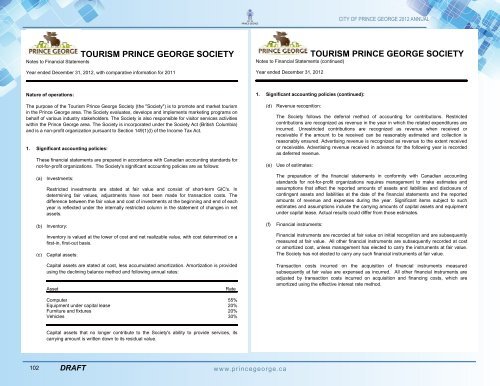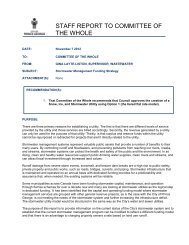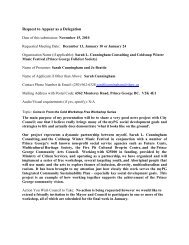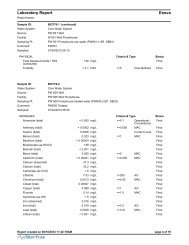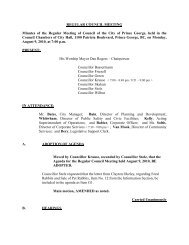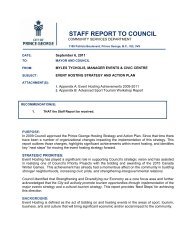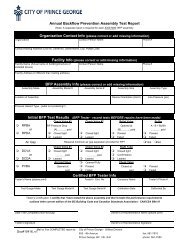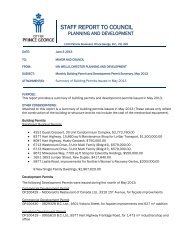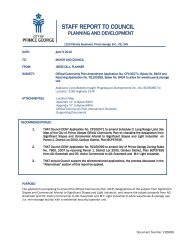2012 City of Prince George Annual Report
2012 City of Prince George Annual Report
2012 City of Prince George Annual Report
Create successful ePaper yourself
Turn your PDF publications into a flip-book with our unique Google optimized e-Paper software.
CITY OF<br />
PRINCE GEORGE<br />
CITY OF PRINCE GEORGE <strong>2012</strong> ANNUAL MUNICIPAL REPORT<br />
TOURISM PRINCE GEORGE SOCIETY<br />
Notes to Financial Statements<br />
Year ended December 31, <strong>2012</strong>, with comparative information for 2011<br />
TOURISM PRINCE GEORGE SOCIETY<br />
Notes to Financial Statements (continued)<br />
Year ended December 31, <strong>2012</strong><br />
Nature <strong>of</strong> operations:<br />
1. Significant accounting policies (continued):<br />
The purpose <strong>of</strong> the Tourism <strong>Prince</strong> <strong>George</strong> Society (the "Society") is to promote and market tourism<br />
in the <strong>Prince</strong> <strong>George</strong> area. The Society evaluates, develops and implements marketing programs on<br />
behalf <strong>of</strong> various industry stakeholders. The Society is also responsible for visitor services activities<br />
within the <strong>Prince</strong> <strong>George</strong> area. The Society is incorporated under the Society Act (British Columbia)<br />
and is a non-pr<strong>of</strong>it organization pursuant to Section 149(1)(l) <strong>of</strong> the Income Tax Act.<br />
1. Significant accounting policies:<br />
These financial statements are prepared in accordance with Canadian accounting standards for<br />
not-for-pr<strong>of</strong>it organizations. The Society's significant accounting policies are as follows:<br />
(d)<br />
(e)<br />
Revenue recognition:<br />
The Society follows the deferral method <strong>of</strong> accounting for contributions. Restricted<br />
contributions are recognized as revenue in the year in which the related expenditures are<br />
incurred. Unrestricted contributions are recognized as revenue when received or<br />
receivable if the amount to be received can be reasonably estimated and collection is<br />
reasonably ensured. Advertising revenue is recognized as revenue to the extent received<br />
or receivable. Advertising revenue received in advance for the following year is recorded<br />
as deferred revenue.<br />
Use <strong>of</strong> estimates:<br />
(a)<br />
Investments:<br />
Restricted investments are stated at fair value and consist <strong>of</strong> short-term GIC's. In<br />
determining fair values, adjustments have not been made for transaction costs. The<br />
difference between the fair value and cost <strong>of</strong> investments at the beginning and end <strong>of</strong> each<br />
year is reflected under the internally restricted column in the statement <strong>of</strong> changes in net<br />
assets.<br />
The preparation <strong>of</strong> the financial statements in conformity with Canadian accounting<br />
standards for not-for-pr<strong>of</strong>it organizations requires management to make estimates and<br />
assumptions that affect the reported amounts <strong>of</strong> assets and liabilities and disclosure <strong>of</strong><br />
contingent assets and liabilities at the date <strong>of</strong> the financial statements and the reported<br />
amounts <strong>of</strong> revenue and expenses during the year. Significant items subject to such<br />
estimates and assumptions include the carrying amounts <strong>of</strong> capital assets and equipment<br />
under capital lease. Actual results could differ from those estimates.<br />
(b)<br />
Inventory:<br />
(f)<br />
Financial instruments:<br />
(c)<br />
Inventory is valued at the lower <strong>of</strong> cost and net realizable value, with cost determined on a<br />
first-in, first-out basis.<br />
Capital assets:<br />
Financial instruments are recorded at fair value on initial recognition and are subsequently<br />
measured at fair value. All other financial instruments are subsequently recorded at cost<br />
or amortized cost, unless management has elected to carry the instruments at fair value.<br />
The Society has not elected to carry any such financial instruments at fair value.<br />
Capital assets are stated at cost, less accumulated amortization. Amortization is provided<br />
using the declining balance method and following annual rates:<br />
Asset<br />
Rate<br />
Transaction costs incurred on the acquisition <strong>of</strong> financial instruments measured<br />
subsequently at fair value are expensed as incurred. All other financial instruments are<br />
adjusted by transaction costs incurred on acquisition and financing costs, which are<br />
amortized using the effective interest rate method.<br />
Computer 55%<br />
Equipment under capital lease 20%<br />
Furniture and fixtures 20%<br />
Vehicles 30%<br />
Capital assets that no longer contribute to the Society's ability to provide services, its<br />
carrying amount is written down to its residual value.<br />
5<br />
102 DRAFT<br />
www.princegeorge.ca<br />
6


